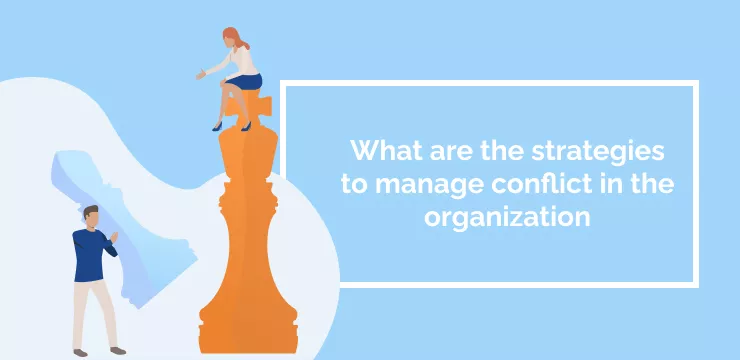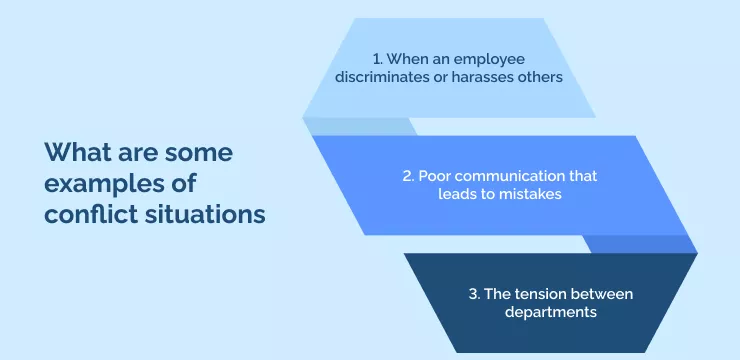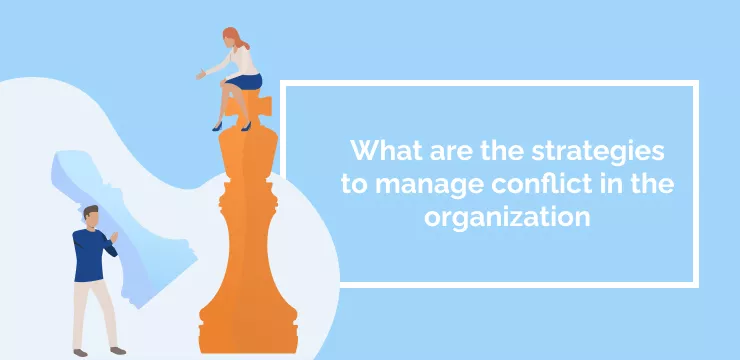
A study by Duke revealed that eighty-five percent of workers experience workplace conflicts. It is inevitable for disagreements to occur, whether during change management initiatives or running day-to-day activities.
Employees should be open to disagreements and collaborate on finding the best solutions to their problems. But you’d find employees afraid of expressing themselves to avoid conflicts, especially with low self-esteem.
Overcoming the fear of organizational conflict is prudent to create a healthy work environment and allow employees to talk freely.
What are the seven different types of conflict?
- Goal conflict– This conflict occurs when there is a clash of goals to accomplish a particular task. In this case, a leader can struggle to convince their team on which goal should be set.
- Cognitive conflict– Prevalent in political debates where an individual can firmly hold to an opinion that differs from those of other colleagues
- Affective conflict– A type of conflict that results from incompatible feelings between different parties
- Behavioral conflict– Arises when an individual behaves in a way that is unacceptable or is against working principles. For example, members who constantly resist change cannot work with others whenever there is a new suggestion.
- Process conflict results from different opinions on how to conduct specific tasks. Some individuals may need to break down the entire process and understand what happens where and when, while others may prefer starting with the first step before deciding on the next steps.
- Role conflict arises when there is a poor allocation of roles or a structural change in the workplace leading to confusion between functional teams.
- External conflicts– Pressure from external stakeholders that affects internal decisions can contribute to a conflicting situation.
What are some examples of conflict situations

1. When an employee discriminates or harasses others
Discrimination can create a conflict when standing against the people who raise the complaints, thus putting them in a grim situation. According to a 2019 NSVRC study, 14% of men and 38% of women experienced sexual harassment at their workplaces. Sexual harassment can be through explicit emails, images, or texts, lewd, unwelcome sexual advances, sexual favor requests, and inappropriate statements.
How to handle discrimination and harassment:
Organizational leaders should take action whenever they hear rumors of harassment or receive actual reports of discrimination. They should listen to the accuser before letting the accused employee explain the causes of the conflicts. After listening, the leaders should approach the conflict with an open mind and emotion-free manner.
2. Poor communication that leads to mistakes
A weakness in message delivery can lead to misinterpretation of instructions which can cause conflicts. For example, a team member constantly interrupting the speaker in a meeting can miss important information and make mistakes.
How to handle communication mistakes
When a group is conducting a meeting, they should practice turn-taking, where every member has to listen to the opinions of others before commenting or talking. The assumption that an opinion from a particular individual is the best is not valid.
3. The tension between departments
Interdepartmental conflicts are another cause of organizational conflicts. It arises when departments have different goals or develop a feeling of being given uneven support from the management. Another challenge is the “silo effect,” with ineffective communication between departments. Poor communication leads to poor collaboration between departments which causes low productivity and tension.
How to handle departmental conflicts:
Centralizing the goals of an organization can reduce the chances of departmental conflict to a possible minimum. As a result, organization leaders must define its objectives, understand how those goals impact different departments and communicate them to each team.
What is conflict theory?
Developed by Karl Marx, conflict theory suggests that due to the unending competition for limited resources, there’ll always be a state of conflict. This theory further explains that wealthy people will protect their resources and hoard them while those without wealth and resources will do whatever possible to obtain those resources. Marx does not explain whether a conflict is good or bad but explains that it is an unavoidable nature of human beings and the conflict theory helps us understand why things are the way they are.
What are the four causes of conflict in the workplace?

1. Limited resources and huge workloads
If an organization has few resources necessary for employees to carry out their tasks, competition for those resources arises. There may also be an unmanageable workload that makes employees feel overworked. Such a situation can be a key to disagreements as concurrent use of the few resources delays job completion.
2. Unclear roles and responsibilities
Poor job descriptions that do not allocate responsibilities to each employee correctly can lead to confusion that will likely cause disagreements. The fear of conflict is high when each team does not have a specific job.
3. Poor communication
Misinformation, inadequate or lack of information, and out-of-context comments can cause rumors and misunderstandings.
4. Unrealistic goals and expectations
When the leadership of an enterprise is only concerned about achieving the organization’s goals without first checking the needs of workers, conflict could arise. For example, an employer may require workers to work off-duty hours. It is the responsibility of the leadership of an enterprise to maintain a healthy working environment that recognizes the workers’ leisure time. Otherwise, they will face resistance from the operational teams and a negative employee experience.
What are the emerging issues in organizational behavior?

Changing Demographics of the Workforce
The dual-career couple profession has risen significantly over the past few years. Although the position is lucrative, it limits individual flexibility. With each partner pursuing a promising career, whose job will they relocate for when the need arises? And when is it okay for one partner to make a risky career change? Managing such couples becomes problematic when family goals and career goals compete.
A Mckinsey report found that dual-career couples are less likely to be happy in their jobs.
So companies need to help such employees manage their work-life balance. For example, providing equal opportunities, encouraging ambition, and creating an organizational culture supporting work-life balance.
Changed Employee Expectations
Times have changed, and employees demand more. They seek empowerment and equality of status with their management. This demand breaks up the customary relationship between senior leaders and employees.
According to Organization Acceleration and Culture Shaping leader Rose Gailey, “Inclusive leadership has become an imperative among teams. Leaders are more intentional in finding ways to bring employees together and ask for their input. Leaders are recognizing that every employee’s personal situation is unique and requires flexibility and understanding in order to make way for them to perform at their best.”
Responding to Globalization
Due to continuous innovation and advancements in technology, businesses have gone global. Today, interaction occurs wherever a market is, irrespective of location, climatic conditions, and distance. Using the internet, mass communication, and modern modes of transport, goods can reach anywhere there is demand. So managers must be proactive and flexible to cope with unfamiliar attitudes, work ethics, and practices.
What are some emerging trends in organizational behavior?
Improving employees’ skills
Due to the dynamic business environment resulting from accelerated technological advancements and environmental and structural changes, employees need the necessary skills to adapt to these changes easily. Employees must undergo training and career development programs to sharpen their technological skills.
Empowering people
Employees’ freedom to choose will enhance their commitment to work and build trust. Empowering employees, in this case, means that an employee receives some ownership for what they do. It helps to reshape the relationship between managers and employees. It also relieves managers of the burden of monitoring everything and makes them coaches or advisors.
Why are role ambiguity, role conflict, and role overload detrimental to the success of individuals and organizations?
Role ambiguity refers to an employee’s lack of clarity, certainty, and predictability towards a particular job in an organization. It occurs due to a lack of clarification or ambiguous job descriptions. Role ambiguity often happens when there is no clear path for managing changes to organizational structures. Therefore, employees tend to have unclear responsibilities leading to low performance, conflicts, and disconnection.
Role conflict refers to incompatible demands placed on a person regarding their job. For example, an employee that must carry out responsibilities with limited guidance on completing the task. Another instance is when an employee has responsibilities that fall between two contradicting job titles. For example, an employee is a data scientist who identifies relevant data sources for the organization but occasionally does technical writing since the organization has no technical writer. Role conflict can cause burnout, confusion, low commitment, and job dissatisfaction in an employee.
Role overload occurs when an individual has more obligations than they can handle. For example, too much work and lack of personal resources are the number one contributors to role overload, which affects an individual’s job performance and psychological safety.
What are the strategies to manage conflict in the organization

1. Understand the situation
Before starting the conflict-solving process, investigate both parties for a clear perspective. Self-awareness is important in bringing an understanding when a disagreement occurs.
2. Acknowledge the problem
Acknowledge the problem and its full extent to begin the solving process instead of underestimating the problem.
3. Avoid making hasty decisions
Hasty decisions have a worse result if they turn out to be wrong decisions. And while making quick decisions, it is easier to make the wrong decision.
4. Control your temper and emotions
A quick temper may cool the complainant to stop speaking, but that does not mean it will solve the problem. The problem will reappear again in the future. It might be better to hand over the matter to someone else with a grip on their emotions.
5. Avoid preconceived attitudes and focus on the problem
Only focus on an individual after conducting a thorough analysis and getting an idea that suggests they are the problem. Otherwise, focus on the problem until you find a solution.
6. Set meeting guidelines
Before starting the meeting between two conflicting parties, make them understand that you need a calm meeting and the consequences of overreacting.
7. Maintain open communication
Conflict resolution aims to have both parties resolve the issue together. Therefore, both parties are free to express their point of view and share their perspectives to create diverse solutions.
8. Act on your decisions
After conducting the meeting and making a decision agreed upon by both parties, it is now time to act. If you leave the issue in limbo, it can damage the parties’ perception of you. Make a firm decision and let everyone know where you stand.
How does understanding management and executive behavior lead to organizational effectiveness and efficiency?
Mastery of organizational behavior can help improve relationships across the organization and provide crucial insights into the staff behaviors, creating a healthy workplace.
Senior leaders who understand organizational behavior can identify and promote positive behavior and shun toxic behaviors in the workplace. In addition, they can evaluate staff performance before inaugurating change.
Organizations are also keen on managerial practices because understanding management theories can help them evaluate their productivity and enhance efficient managerial decision-making. Organizations can identify which management practices best suit them and create a productive work environment.
How does organizational structure affect project management?
An organization should be cautious about which structure to adopt as it dictates how well projects are undertaken from initiation to closure. Choosing the proper organizational structure can be pretty overwhelming. Organizations must understand whether the project is complex, simple, or intermediate. They should also assess the project’s budgets, objectives, resources required, and overall risks in undertaking the project.
Three structures dictate the success or failure of project management:
1. Functional structure
In a functional structure, the project manager doesn’t have complete authority over the project. Instead, they report directly to the functional manager. The functional manager has total power over the project and makes critical decisions.
In a functional structure, projects are implemented under the functional unit of the organization. As a result, the projects can utilize the organization’s resources, including tools, equipment, and human resources, to achieve the project’s objective.
On the negative side, the decision-making process is tedious because the project manager has to seek clarification from the functional manager. Thus, limiting the project manager from directly responding to clients’ complaints.
2. Projectized Structure
The projectized structure gives the project manager complete control over the project. As a result, project managers can run the whole project as a separate entity from the lead organization. Since the project manager has the authority over the project, team members directly report to one manager, allowing them to focus on the actual work.
The main disadvantage of this approach is when an organization is implementing multiple projects independently. For instance, If the company tends to carry out various projects simultaneously, each project will require its technical expertise, equipment, and tools. With no room for sharing resources, the cost of independently acquiring each project’s resources can be pretty expensive.
3. Matrix Structure
The matrix structure is more like a hybrid structure that incorporates the strengths of both the projectized and functional structures. As a result, organizations have a broader potential to counter challenges.
The matrix approach saves the organization’s finances since there is easier and more efficient management of project resources. On the downside, it can be tough to manage people and other equipment making it hard to achieve the project’s objective.
An efficient organizational structure that clearly defines both the roles of senior managers and project managers is prudent for any project to be successful. It also eliminates any organizational conflict that would otherwise occur from a misunderstanding between the two bosses.
How does organizational culture affect individual and overall performance?
Organizational structure is a set of beliefs, values, and rituals that dictate how employees in an organization interact with their co-workers and accomplish tasks. A good organizational culture gives employees a sense of belonging and identity.
Adobe, an American Software company, has achieved success thanks to its organizational culture that focuses on honesty, trust, and belief in treating employees equally. Employees receive tuition reimbursement and discounted gym memberships. In addition, the company holds annual banquets to award their creative employees who participate in launching new products. Employees also get patents for their ideas plus huge bonuses.
On the other hand, a toxic organizational culture is detrimental to success. Employees don’t have the freedom to express themselves, which eventually pushes them to seek better opportunities.
A company that does not reward or acknowledges employees for their efforts portrays a poor organizational culture. Recognizing only top performers and leaving out the rest can create hatred and competition in the organization.
What are the theories of conflict management?
Conflict management has two theories:
- Contemporary theory– This theory suggests that conflicts between individuals are unavoidable. Conflicts emerge naturally from change, and if we manage conflicts efficiently, they can benefit the organization.
- Traditional theory– This theory focuses on avoiding conflict. It recognizes conflicts as bad situations that emerge from troublemakers; hence people should not cause conflicts.
Which conflict management strategy is considered a “win-win”?
A conflict management strategy that is a “win-win” is one where both parties undergoing conflict understand each other and get what they need the most. An excellent example of a conflict management strategy is starting with facts and not judgments.
Having neutral observations will most likely create a suitable environment for rational and reasonable conversations. Sharing your observations will open doors for more discussions focused on the issue without the parties having to argue. Doing this will create a win-win situation where the two parties will quickly reach an agreement, and the organization will also win because the employees will now be more productive.
When a business can overcome its employees’ fears of organizational conflict, it will create a favorable work environment for its employees and other key stakeholders. Overcoming fear of organizational conflict will also give employees a chance to speak to their bosses if mistreated, overworked, or harassed. As a result, employees will commit to their tasks, improving the entire organization’s productivity.
WalkMe Team
WalkMe spearheaded the Digital Adoption Platform (DAP) for associations to use the maximum capacity of their advanced resources. Utilizing man-made consciousness, AI, and context-oriented direction, WalkMe adds a powerful UI layer to raise the computerized proficiency, everything being equal.



